Patents
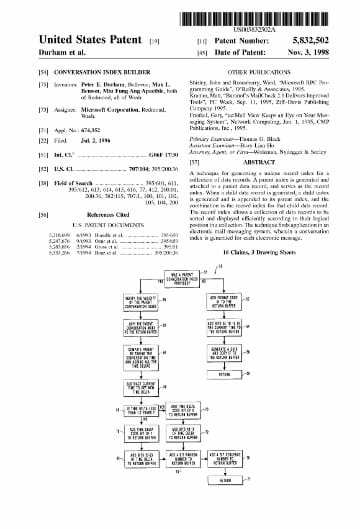
Conversation index builder
US Patent 5,832,502
November 3, 1998
Peter E. Durham, Max L. Benson, Miu Fung Ang Apacible
A technique for generating a unique record index for a collection of data records. A parent index is generated and attached to a parent data record, and serves as the record index. When a child data record is generated, a child index is generated and is appended to its parent index, and the combination is the record index for that child data record. The record index allows a collection of data records to be sorted and displayed efficiently according to their logical position in a collection. The technique finds application in an electronic mail messaging system, wherein a conversation index is generated for each electronic message.
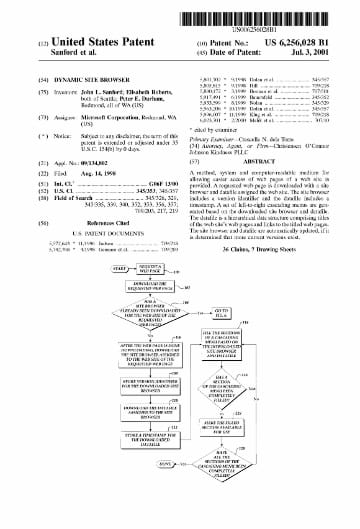
Dynamic site browser
US Patent 6,256,028
July 3, 2001
John L. Sanford, Elisabeth Roberts, Peter E. Durham
A method, system and computer-readable medium for allowing easier access of web pages of a web site is provided. A requested web page is downloaded with a site browser and datafile assigned the web site. The site browser includes a version identifier and the datafile includes a timestamp. A set of left-to-right cascading menus are generated based on the downloaded site browser and datafile. The datafile is a hierarchical data structure comprising titles of the web site's web pages and links to the titled web pages. The site browser and datafile are automatically updated, if it is determined that more current versions exist.
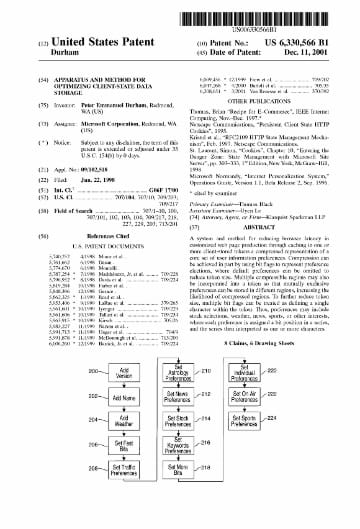
Apparatus and method for optimizing client-state data storage
US Patent 6,330,566
December 11, 2001
Peter E. Durham
A system and method for reducing browser latency in customized web page production through caching in one or more client-stored tokens a compressed representation of a core set of user information preferences. Compression can be achieved in part by using bit flags to represent preference elections, where default preferences can be omitted to reduce token size. Multiple compressible regions may also be incorporated into a token so that mutually exclusive preferences can be stored in different regions, increasing the likelihood of compressed regions. To further reduce token size, multiple bit flags can be treated as defining a single character within the token. Thus, preferences may include stock selections, weather, news, sports, or other interests, where each preference is assigned a bit position in a series, and the series then interpreted as one or more characters.
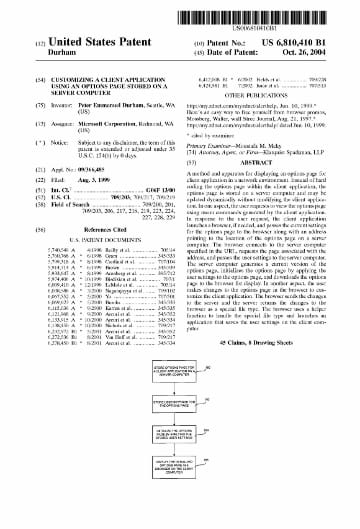
Customizing a client application using an options page stored on a server computer
US Patent 6,810,410
October 26, 2004
Peter E. Durham
A method and apparatus for displaying an options page for client application in a network environment. Instead of hard coding the options page within the client application, the options page is stored on a server computer and may be updated dynamically without modifying the client application. In one aspect, the user requests to view the options page using menu commands generated by the client application. In response to the user request, the client application launches a browser, if needed, and passes the current settings for the options page to the browser along with an address pointing to the location of the options page on a server computer. The browser connects to the server computer specified in the URL, requests the page associated with the address, and passes the user settings to the server computer. The server computer generates a current version of the options page, initializes the options page by applying the user settings to the options page, and downloads the options page to the browser for display. In another aspect, the user makes changes to the options page in the browser to customize the client application. The browser sends the changes to the server and the server returns the changes to the browser as a special file type. The browser uses a helper function to handle the special file type and launches an application that saves the user settings on the client computer.
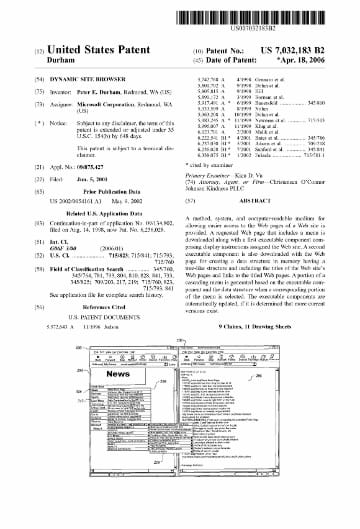
Dynamic site browser
US Patent 7,032,183
April 18, 2006
Peter E. Durham
A method, system, and computer-readable medium for allowing easier access to the Web pages of a Web site is provided. A requested Web page that includes a menu is downloaded along with a first executable component comprising display instructions assigned the Web site. A second executable component is also downloaded with the Web page for creating a data structure in memory having a tree-like structure and including the titles of the Web site's Web pages and links to the titled Web pages. A portion of a cascading menu is generated based on the executable component and the data structure when a corresponding portion of the menu is selected. The executable components are automatically updated, if it is determined that more current versions exist.
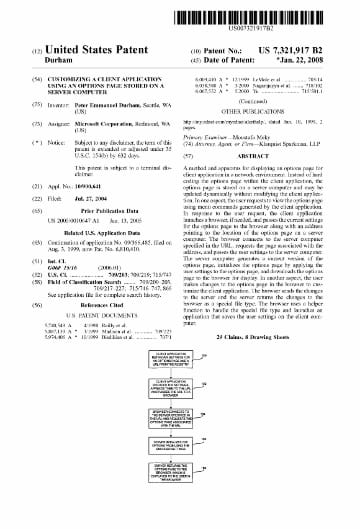
Customizing a client application using an options page stored on a server computer
US Patent 7,321,917
January 22, 2008
Peter E. Durham
A method and apparatus for displaying an options page for client application in a network environment. Instead of hard coding the options page within the client application, the options page is stored on a server computer and may be updated dynamically without modifying the client application. In one aspect, the user requests to view the options page using menu commands generated by the client application. In response to the user request, the client application launches a browser, if needed, and passes the current settings for the options page to the browser along with an address pointing to the location of the options page on a server computer. The browser connects to the server computer specified in the URL, requests the page associated with the address, and passes the user settings to the server computer. The server computer generates a current version of the options page, initializes the options page by applying the user settings to the options page, and downloads the options page to the browser for display. In another aspect, the user makes changes to the options page in the browser to customize the client application. The browser sends the changes to the server and the server returns the changes to the browser as a special file type. The browser uses a helper function to handle the special file type and launches an application that saves the user settings on the client computer.